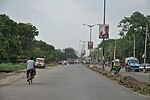Barrackpore Government High School

Barrackpore Government High School is situated on Barrackpore Trunk Road near Talpukur in Barrackpore, India and was established in 1837. Until recently it was believed that the school was established by Emily Eden. However, research gives credit to her elder brother George Eden, 1st Earl of Auckland the then Governor-General of India. He opened and ran the school at his own expense. The school continues to run from the heritage central building which is highly reminiscent of Collegiate Neo-Gothic architecture typical to nineteenth century British constructions. The school has been referred as Eden School, Vice-regal School, Viceroy's Park School, Governor's School, Barrackpore Government Park School in government archives, newspapers and journals. It is now referred as Barrackpore Government School or Barrackpore Government High School.
Excerpt from the Wikipedia article Barrackpore Government High School (License: CC BY-SA 3.0, Authors, Images).Barrackpore Government High School
AT Road, Barrackpore
Geographical coordinates (GPS) Address Nearby Places Show on map
Geographical coordinates (GPS)
| Latitude | Longitude |
|---|---|
| N 22.750797222222 ° | E 88.368105555556 ° |
Address
AT Road
AT Road
700120 Barrackpore
West Bengal, India
Open on Google Maps







